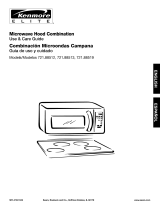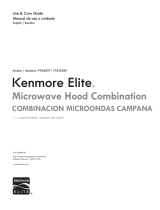
- 4 -
SAFETY
IMPORTANT SAFETY INSTRUCTIONS
The safety instructions below will tell you how to use your oven and avoid harm to yourself or
damage to your oven.
WARNING - To reduce the risk of burns,
electric shock, re, injury to persons, or exposure to
excessive microwave energy:
•
Read all the instructions before using your oven.
•
Do not allow children to use this oven without
close supervision.
• Read and follow the specic PRECAUTIONS TO
AVOID POSSIBLE EXPOSURE TO EXCESSIVE
MICROWAVE ENERGY found on page 2.
• Do not use corrosive chemicals or vapors, such as
sulde and chloride, in this appliance. This type of
oven is specically designed to heat, cook, or dry
food. It is not designed for industrial or laboratory
use.
• Do not store this appliance outdoors. Do not
use this product near water - for example, near a
kitchen sink, in a wet basement, near a swimming
pool, or similar location.
• Do not use the cavity for storage purposes. Do not
leave paper products, cooking utensils, or food in
the cavity when not in use.
• Clean the ventilating hood frequently. Do not
allow grease to accumulate on the hood or the
lters.
• Use care when cleaning the vent hood lters.
Corrosive cleaning agents, such as lye-based oven
cleaners, may damage the lters.
• Do not tamper with the built-in safety switches
on the oven door. The oven has several built-in
safety switches to make sure the power is off when
the door is open.
• When food ames under the hood, turn the fan on.
• Suitable for use above both gas and electric
cooking equipment 36 inches wide or less.
• Do not use this oven for commercial purposes.
It is made for household use only.
• When cleaning the door and the surfaces that
touch the door, use only mild, non-abrasive
soaps or detergents and a sponge or soft cloth.
• If your oven is dropped or damaged, have
it thoroughly checked by a qualied service
technician before using it again.
• To avoid a re hazard:
-
Do not severely overcook food. Severely
overcooked foods can start a re in the oven.
Watch the oven carefully, especially if you have
paper, plastic, or other combustibles in the oven.
-
Do not store combustible items (bread, cookies,
etc.) in the oven, because if lightning strikes the
power lines it may cause the oven to turn on.
- Do not use wire twist-ties in the oven. Be sure
to inspect purchased items for wire twist-ties and
remove them before placing the item in the oven.
• If a re should start:
- Keep oven door closed
- Turn the oven off
- Disconnect the power cord or shut off power
at the fuse or circuit breaker panel
• To avoid electric shock:
- This appliance must be grounded. Connect only
to a properly grounded outlet. See the electrical
GROUNDING INSTRUCTIONS on page 6.
- Do not operate this appliance if it has a
damaged cord or plug, if it is not working
properly or if it has been damaged or dropped.
- Do not immerse the electrical cord or plug in
water.
- Keep cord away from heated surfaces.
- Do not let cord hang over edge of table or
counter.
• Take care when The Door is opened.
There is a possibility of being injured.
• When range or cooktop, located below the
microwave, is in operation, PLEASE USE
CAUTION IN OPERATING THE MICROWAVE AS
ITS COMPONENTS SUCH AS DOOR HANDLE
MAY BE OVERHEATED CAUSING BURNS AND/
OR INJURY.
• To avoid improperly cooking some foods.
- Do not heat any types of baby bottles or baby
food. Uneven heating may occur and possibly
cause personal injury.
- Do not heat small-necked containers,
such as
syrup bottles.
- Do not deep-fat fry in your microwave oven.
- Do not attempt home canning in your microwave
oven.
- Do not heat the following items in the microwave
oven:
whole eggs in the shell, water with oil or fat,
sealed containers, or closed glass jars. These
items may explode.





















